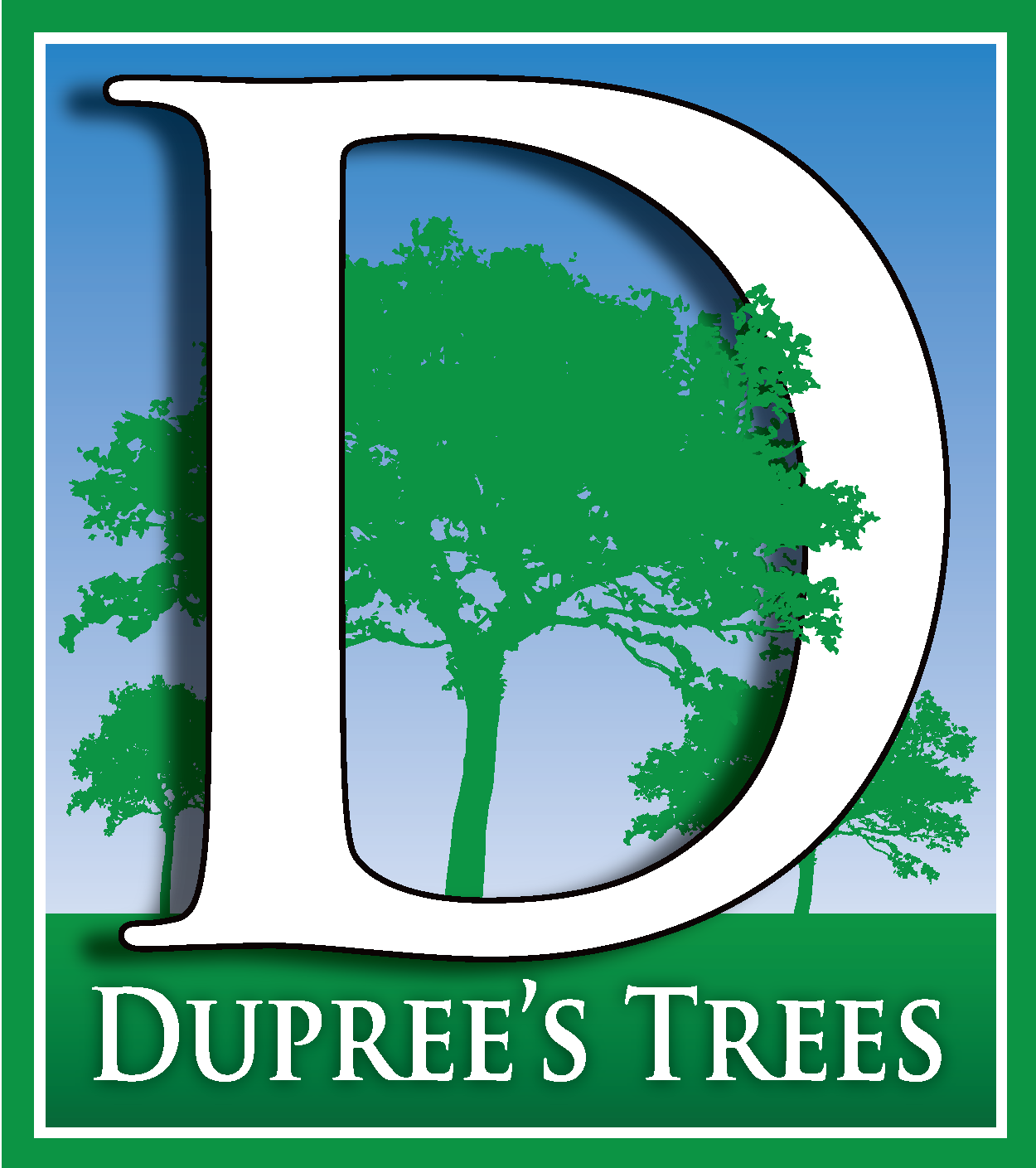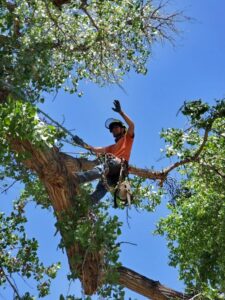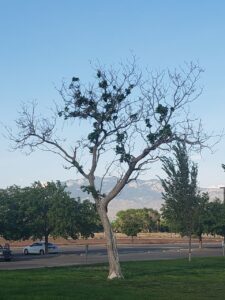Our leafy friends have a knack for popping up in inconvenient places; between sidewalk cracks, next to garages, against fences. If they’re too close to your house, they can eventually cause damage. You might be wondering, how far should trees be trimmed from your house?
General guidelines for trimming trees close to your house
Depending on your city, county, or state, local government may have different rules about how close your trees and branches can be to your home. The farther away your trees are from your house, the better. Roots can cause tremendous problems with foundations, pipes, and basements by upheaving concrete slowly over the decades. Hidden diseases like heart rot can create a danger of a tree uprooting and falling on the house. And of course, falling limbs can cost you tens of thousands of dollars in roof repairs too.
So how far should trees be trimmed back from your home? Here are some guidelines from our professional tree trimmers:
- At least 3 feet between the tree canopy and roof. Tree branches rubbing against your roof can lead to damaged shingles and create entry points for pests. A 3 foot clearance helps prevent abrasion damage.
- 5-10 feet between trees and siding/walls. This prevents branches from rubbing against siding, which can scrape off paint and create openings for rot. It also reduces dampness on walls from excessive shade.
- 10-15 feet between trees and foundation. Tree roots growing too close to your home’s foundation can crack and shift it. Trimming trees back 10 feet or more creates a root buffer zone.
- 15-20 feet between trees and driveways/walkways. Trees hanging over paved areas can drop leaves, seeds, sap, and other debris requiring additional cleaning. Trimming them back helps minimize messes.
- 25 feet or more between trees and storm drains/underground utilities. Tree roots can infiltrate and clog drains or warp underground water and sewer pipes if too close. A 25 foot clearance reduces this risk.

Here are some other factors for you to consider:
Fire Safety
Having trees and shrubs near your home can spell danger in regions vulnerable to wildfires. Tree limbs, leaves, and needles hanging near or touching the house fuel fires to spread. This allows flames to ignite the home’s exterior easily and provides a pathway for fire to reach the roof and other vulnerable areas. Even ember showers from distant fires can ignite dry vegetation touching the house. Proper tree trimming to maintain at least a 3-5 foot buffer between branches and the roofline, siding, eaves, and windows reduces this fire hazard significantly. Clearing away underbrush and lower branches also helps prevent ground fires from scaling trees and reaching upper floors. Taking fire prevention measures by pruning back trees to create defensible space around homes is especially critical in wildfire zones. This gives firefighters a better chance of saving homes if a fire approaches.
Tree Height Consideration
A tree’s mature height is a key factor when determining an appropriate distance from your home for trimming or planting, according to our tree care experts. Taller trees require wider buffers between branches and your house. Here’s why:
Large trees like oaks, pines, and maples can grow upwards of 60-100 feet tall or more. Their extensive root networks and heavy branches place greater pressure on the structural integrity of nearby buildings. Overhanging limbs and leaves can also accumulate in large piles on your roof, clogging gutters. Likewise, the broader canopy of mature tall trees casts wider shadows and sheds more debris like seeds, pods, and needles onto your home. This necessitates aggressive trimming and cleanup.
Large mature trees should be trimmed back 20-30 feet from houses to avoid future foundation and roof damage. Saplings should be planted at least 30 feet away. Medium trees topping out at 30-60 feet ought to be trimmed 10-15 feet back once fully grown. Smaller varieties only reaching 15-30 feet need 5-10 feet of clearance.
Properly spacing trees of all sizes minimizes hazards while retaining their aesthetic and environmental value.
Branch Overhang
Branches extending over your roof may seem harmless but can cause several problems. Accumulated leaves and debris can clog gutters, leading to interior water damage. Excess leaf litter also provides nesting material for squirrels, raccoons, and other pests that may damage your roof.
During winter, additional snow weight sitting on overhanging branches poses risks. The burden of heavy, wet snow can cause branches to crack or entire trees to topple onto your home. Snow-laden limbs also dump large piles onto your roof when dislodged, which can collapse under the added load.
Keeping trees properly trimmed several feet back from the roofline prevents hazards related to accumulated leaves and overloaded branches. This also allows for easy gutter cleaning and roof maintenance without obstruction. Contact our arborists to inspect overhanging trees and determine how far should trees be trimmed from your house to protect your roof from damage year-round.
Utility Lines
How far should trees be trimmed from your house? Far enough to avoid utility lines.
In addition to trimming trees away from structures, sufficient clearance around overhead power lines is critical. Trees growing too close to utility lines cause significant public safety and outage risks. Branches can snap electrical wires, rupture gas lines, and interrupt cable or telephone service if they make contact.
During storms, tangled limbs also put repair crews in harm’s way when fixing damaged lines. Likewise, power surges from touching wires can also shock or electrocute homeowners trimming trees. Preventative trimming is the key. To maintain safe separation, trees adjacent to utility poles or wires should be trimmed at least 10 feet back horizontally. Even wider 15-20 foot buffers are ideal for areas prone to wind and ice storms. Proper tree and utility line clearance eliminates hazards while keeping the lights on.
The Impact of Root Systems
A tree’s spreading root system poses threats beyond overhanging branches. Roots growing unchecked near your home’s foundation can wreak havoc below ground too. Actively expanding root networks apply immense horizontal and vertical pressure on foundation walls and footings. This relentless force can crack cinderblock, concrete, or shift the entire structure. Root invasion through tiny cracks or joints can further destabilize the foundation. Drain pipes, water lines and septic systems also fall victim to invading roots. As roots permeate and block these lines, backups, leaks and water damage inside the home can result.
Keeping trees at least 10-15 feet from the foundation avoids root damage. For plumbing and septic systems, a 25 foot distance is safer. If existing trees already show signs of foundation or pipe damage, more aggressive root pruning or removal may be necessary. Learn more about stopping tree root issues in our related article “How to Stop Trees from Damaging Your Driveway or House Foundation.”
The Best Time to Trim
In addition to the proper trimming distance, timing is also crucial. When should tree trimming occur to avoid pest infestations, disease, or damage to your home? Late winter is ideal for most tree species.
Dormant trees in winter experience less shock from pruning wounds versus active spring growth. Branches are also clearly visible for easier trimming when devoid of leaves. The one exception is dead or damaged limbs, which should get removed immediately regardless of season.
Avoid trimming in early spring when trees are budding, as this drains energy reserves needed for new growth. Similarly, pruning in late summer stresses trees already drained from producing leaves and fending off pests. Learn more tips on timing and signs your trees need pruning in our in-depth article “When is the Best Time to Prune a Tree?”
Tree Health
Aggressive over-trimming poses significant risks beyond just an ugly appearance. Removing too much healthy foliage starves trees of the energy they need from photosynthesis. Excessive pruning also leaves gaping wounds vulnerable to infestations and disease.
When trimming, arborists take care to selectively remove no more than 25% of a tree’s live branches at one time. This prevents shock and preserves the tree’s natural shape. Improper cuts that shred or split branches also introduce infections. And “topping” trees by decapitating the top leaves hazardous stumps that quickly decay.
Proper technique, timing and restraint prevents undue stress on your trees. Always hire a certified tree specialist or arborist to assess trimming needs and prune carefully. Avoid so-called “tree hacks” who butcher trees, potentially leading to sickness and death. Healthy, vibrant trees depend on expert trimming for longevity.
Insurance Considerations
Home insurance providers pay close attention to tree placement and care around your house. Neglected trees too close to your home can increase risks for the insurer and may affect your policy.
Overhanging branches that come in contact with your roof raise the hazard of storm damage claims. Likewise, unchecked tree roots infiltrating foundations and plumbing lines lead to expensive repairs. Insurance agents may inspect your property and require diseased or hazardous trees near the home to be removed before issuing a policy.
Maintaining an adequate distance between how far should trees be trimmed from your house demonstrates risk mitigation. Consistent pruning and care also show you are actively minimizing dangers from falling limbs, pests, and root damage. Documenting your regular tree maintenance provides proof to insurers that potential perils remain in check.
Promoting tree health and safety around your home benefits you and your insurer. Be sure to discuss tree placement and care with agents when purchasing or renewing your policy. Doing your part to control risks can prevent coverage issues down the road.
DIY Trimming Considerations
While hiring a professional is best, you can safely prune smaller trees yourself by following these guidelines:
- Use sharp bypass pruners or loppers to make clean cuts and avoid tearing bark. Never use hedge trimmers on branches over half inch diameter.
- Wear safety glasses, hard hat, and gloves to prevent eye injuries and splinters. Hearing protection also helps when using loud chainsaws.
- Check for electrical wires before cutting and avoid pruning near utilities. Contact your service provider to shut off power if necessary.
- Use fiberglass ladders and prune with both feet firmly on the ladder’s platform. Don’t overreach or climb trees to trim.
- Make gradual, smaller cuts rather than whacking off large limbs completely. This prevents heavy falling branches.
- Only prune in dry weather and never use power tools on a wet tree or ladder. Electrocution risks soar.
- Know your limits and leave the big stuff to the pros! Anything higher than you can reach from the ground warrants an arborist’s expertise.
Stay safe and care for your trees with proper tools, technique, and caution.
Unsure how far should trees be trimmed from your house? Get expert help
Determining how far trees should be trimmed from your house depends on tree size, age, species, and location relative to your roof, foundation, and utilities. Striking the right balance protects your home without unnecessarily sacrificing your landscape’s beauty. When unsure, consult with the knowledgeable arborists at Duprees Trees. Our certified team can inspect your property, identify any hazards, and recommend a customized trimming plan for tree health and home safety. Book a consultation today and let us assess your trees to help determine that ideal distance. With our expertise, your trees and home can coexist harmoniously for generations. Schedule a FREE estimate with us at this link.




